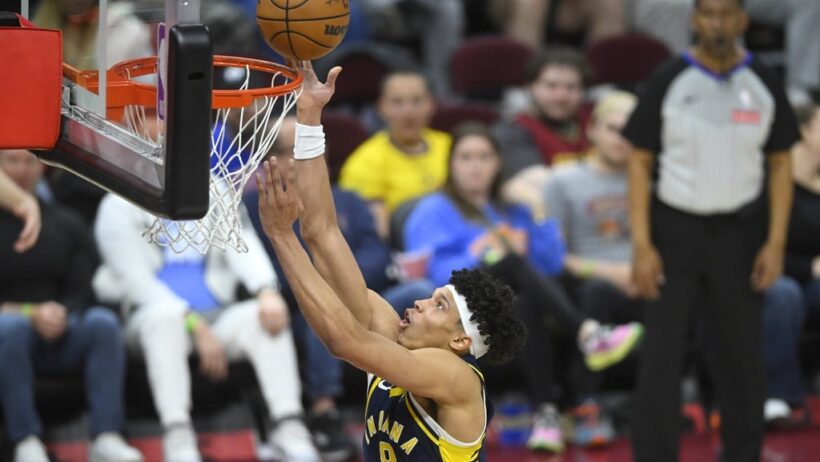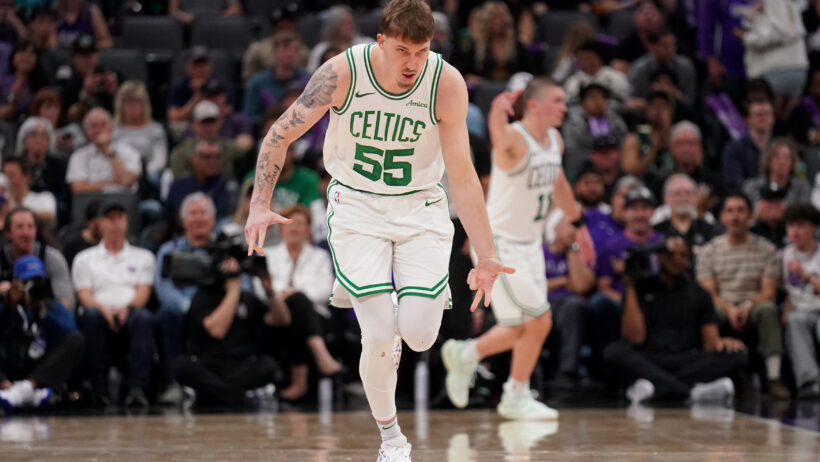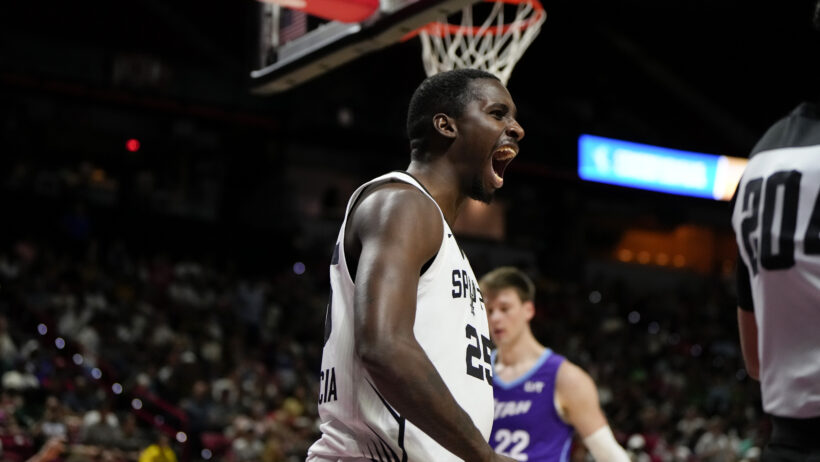NBA Public Betting Trends – Daily Bet and Money Percentages
Public betting trends are not currently available.
We don't have public betting splits for upcoming games yet. Check back soon!
Check out NBA Basketball futures odds for now!
Latest NBA Basketball News, Picks & Analysis
By Sascha Paruk
Updated:
NBA Public Betting Splits for Sunday, June 22nd
It’s do-or-die for both teams in Sunday’s Game 7 between the OKC Thunder and Indiana Pacers. The significant NBA public-betting splits for Game 7 of the 2025 NBA Finals include the following:
- The Thunder are getting slightly more ML wagers (54%) but the Pacers are getting way more moneyline handle (78%), indicating that the bigger bets are on the Pacers to win outright.
- The public is hammering the over, putting 89% of O/U handle on over 214.5 as of 9:33 am ET on Sunday morning.
- BETMGM SPORTSBOOK
USE CODE SBD1500 & GET $1,500 BACK IN BONUS BETS
- BET365 SPORTSBOOK
BET $5 & GET $150 IN BONUS BETS WITH CODE DIME365
- FANATICS SPORTSBOOK
BET & GET UP TO $1,000 IN BONUS BETS!
- DRAFTKINGS SPORTSBOOK
BET $5 & GET $150 IN BONUS BETS INSTANTLY!
- FANDUEL SPORTSBOOK
BET $5 & GET $150 IF YOUR BET WINS
- CAESARS SPORTSBOOK
USE CODE SBD2DYW & BET $1 TO DOUBLE THE WINNINGS ON YOUR FIRST 10 BETS!
Must be 21+. GAMBLING PROBLEM? Call 1-800-GAMBLER (CO, IL, KS, KY, MD, MI, NC, NJ, OH, PA, TN, VA, VT, WV, WY); (800) 327-5050 or gamblinghelplinema.org (MA); (877) 8-HOPENY (NY); 1-800-NEXT-STEP (AZ); (888) 789-7777 (CT); 1-800-BETS-OFF (IA); 1-800-9-WITH-IT (IN); mdgamblinghelp.org (MD); morethanagame.nc.gov (NC); 1800gambler.net (WV)
Looking for the latest NBA odds? Get current spreads, totals, and moneyline odds for all games this week here.
Public’s NBA Betting Record
What Are NBA Betting Trends and How Do I Use Them?
Every bet placed on NBA games is tracked and entered in to a system at your sportsbook of choice. Using all those transactions, bettors, analysts and fans alike can track trends based off the total number of bets placed and total amount of money bet on any game across the spread, moneyline or over/under total markets.
With that data, you can see the public consensus (as well as where the sharp money is) for every game before placing your bet.
What’s the Difference Between Bet and Money Percentages?
Money percentages – or percent of the handle – refers to the total amount of money wagered on an event, often broken down by bet type.
The money percentage pools all the money wagered on any game together, first sorting it by the type of bet (moneyline, spread, or total points scored), and then breaks down what percentage of the handle is bet on each side.
Whichever side the handle is weighted to can signal the sharp action (if the amount of tickets on that side are low), or if that side is being heavily bet by the public (if the ticket percentage is high).
Bet percentages, meanwhile, are frequently referred to as “% of tickets” or “% of bets”. Tickets are just a term used for all the bets placed.
To get the bet percentage, you look at all the bets placed (regardless of the amount of money risked on each one), again, sorting first by the type of bet, and then look at the percentage of tickets on each side of the game.
This can help identify which side both high-stakes and low-stakes players are trending towards.
Noticing Sharp Action While Betting on the NBA
As broken down above, ticket percentage does not consider the amount risked on each ticket – it just counts each bet placed. If we compare the bet percentage and money percentage of the same team (for the same bet type), you’ll notice the sharp action if the figures aren’t similar.
For example, if the Lakers have 86% of the tickets bet against the spread, but only has 47% of the money, we now know the bets being placed on the Lakers are quite small – or the bets being placed on the opponent are quite large.
A noticeable difference between a team’s bet and money percentages can help signal sharp action. In order to calculate this, just subtract their bet percentage from their money percentage. If the result is a positive number, you’ve got larger bets being placed on this team. If the result is a negative number, you’ve got larger bets being placed on the other team.
While that’s not a 100% accurate formula to determine the sharp action, it can give you a general idea of where the money is.
Know the Trends? Time to Pick an NBA Betting Promo
Now that you’ve looked into NBA public betting trends, you’ll want to make sure you’ve claimed as many sweet sportsbook promos as possible before placing your bets.
Snagging a DraftKings promo code means you can cash in on their sign-up bonus and score daily odds boosts for bigger payouts. FanDuel is another big name in NBA betting, so don’t forget to grab a FanDuel promo code to enhance your betting success.
BetMGM is always dishing out bonus bets, so make sure you sign up with the ‘King of Sportsbooks’ and get the best BetMGM promo code for their $1,000 First Bet Offer. Caesars Sportsbook is no slouch either. Grab the latest Caesars Sportsbook promo code, and don’t forget to check out their Quick Picks that feature prebuilt parlays with boosted odds.
Last but not least, the Bet365 bonus code unlocks a Bet $1, Get $200 in Bonus Bets promotion, which you won’t want to miss out on for all your NBA wagers. These huge NBA betting promo codes will help you make the most of your betting experience and boost your chances of bringing home the win.
SBD has also created a page dedicated to tracking the daily odds boosts at every North American sportsbook.
- BETMGM SPORTSBOOK
USE CODE SBD1500 & GET $1,500 BACK IN BONUS BETS
- BET365 SPORTSBOOK
BET $5 & GET $150 IN BONUS BETS WITH CODE DIME365
- FANATICS SPORTSBOOK
BET & GET UP TO $1,000 IN BONUS BETS!
- DRAFTKINGS SPORTSBOOK
BET $5 & GET $150 IN BONUS BETS INSTANTLY!
- FANDUEL SPORTSBOOK
BET $5 & GET $150 IF YOUR BET WINS
- CAESARS SPORTSBOOK
USE CODE SBD2DYW & BET $1 TO DOUBLE THE WINNINGS ON YOUR FIRST 10 BETS!
Must be 21+. GAMBLING PROBLEM? Call 1-800-GAMBLER (CO, IL, KS, KY, MD, MI, NC, NJ, OH, PA, TN, VA, VT, WV, WY); (800) 327-5050 or gamblinghelplinema.org (MA); (877) 8-HOPENY (NY); 1-800-NEXT-STEP (AZ); (888) 789-7777 (CT); 1-800-BETS-OFF (IA); 1-800-9-WITH-IT (IN); mdgamblinghelp.org (MD); morethanagame.nc.gov (NC); 1800gambler.net (WV)




